



Pharaon des deux terres. L'épopée africaine des rois de NapataPharaoh of the two lands. The African epic of the kings of Napata
Photos: Musée du Louvre

Du 28 avril au 25 juillet 2022, le musée du Louvre consacre pour la première fois une exposition aux pharaons noirs. Elle est qualifiée d'"exigeante" par les organisateurs tant le public a peu de connaissances sur ces souverains. C'est l'occasion de revenir sur leur épopée, leurs conquêtes et leur histoire, qui ont profondément marqué l'Égypte.
Pendant des siècles les Égyptiens ont colonisé le pays de Kouch, en Nubie (dans l'actuel Soudan). Ils ont imposé leur souveraineté, leur religion et leurs valeurs au peuple et aux rois kouchites. "Et ces rois de Kouch ont fini par adopter à ce point les façons de faire pharaoniques et égyptiennes qu'ils sont devenus en quelque sorte plus pharaons que les pharaons"
déclare Vincent Rondot, commissaire de l'exposition.
En 720 avant J.-C. l'Égypte divisée, fragile, est menacée par les Assyriens. Et finalement, le roi Kouchite Piânkhy, venu de la lointaine Napata, ville sacrée située au pied du Djebel Barkal (Montagne-Pure) va décider de profiter de cette vulnérabilité. Depuis Napata, il lance ses armées à la conquête des villes de la vallée du Nil, jusqu'à Memphis. Une véritable épopée dont on connaît les détails grâce à la stèle triomphale de Piânkhy (présentée à l'expo).
Ses successeurs forment la XXVe dynastie, dite Kouchite. Ils se placent sous la protection des dieux égyptiens (notamment Amon) et produisent des stèles pour réaffirmer les éléments fondateurs de la religion traditionnels égyptienne : "non seulement ils connaissaient bien cette culture égyptienne mais ils ont cherché à revenir à ses sources, à s'informer dans les archives égyptiennes, selon un mode de fonctionnement typiquement égyptien, des textes théologiques les plus anciens, qu'ils font recopier sur pierre. L'art de cette époque
"va se laisser influencer par les plus beaux modèles de l'Ancien Empire, par exemple"
(D. Valbelle). Signalons au passage que les pharaons noirs sont les seuls à porter deux uræi au front, l'un pour Kouch, l'autre pour l'Égypte.
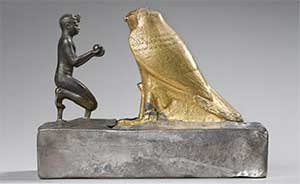
Taharqa (690-664 BCE) est le souverain Kouchite le mieux connu. Grand bâtisseur, il a construit ou augmenté plus de temples, créé plus de statues colossales et laissé derrière lui plus d'inscriptions, qu'aucun autre souverain depuis Ramsès II. Il veut laisser le souvenir d'un homme pieux et bienveillant, d'un brillant stratège militaire, et d'un souverain habile politicien. Il est fait mention de lui dans les Annales assyriennes et la Bible. Et le géographe grec Strabon, qui a vécu quelques 700 ans après Taharqa, le cite comme l'un des grands conquérants du monde antique.
Pendant près d'un siècle, les pharaons noirs règnent sur l'Égypte. Ils en sont chassés, non par les Égyptiens, mais par les Assyriens qui détruisent Thèbes en 664 av. J.-C. Une mise à sac de la ville par les armées d'Assurbanipal dont la férocité destructrice trouve des échos jusque dans la Bible.
Cependant, dans la ville de Saïs, dans le Delta, des princes qui n'avaient jamais reconnu l'autorité des Kouchites, forment la XXVIe dynastie, période de prospérité où le pays renoue avec les traditions anciennes, au point qu'on parle de la "Renaissance" saïte. Psammétique II, second roi de la dynastie, à la tête d'une armée hétéroclite (avec de nombreux Grecs) remontera jusqu'à Napata, qui est détruite en 593 av. J.-C. Le souvenir de cette épopée a traversé les siècles : le thème central de Aïda, l'Opéra de Giuseppe Verdi, évoque les destins tragiques du roi de Kouch Amanislo et de sa fille, réduite en esclavage par Pharaon.

From April 28 to July 25, 2022, the Louvre Museum is devoting an exhibition to the Black Pharaohs, which has been described as "demanding" because the public knows so little about these rulers. It is an opportunity to revisit their epic, their conquests and their history, which deeply marked Egypt.
For centuries the Egyptians colonised the country of Kush, in Nubia (in present-day Sudan). They imposed their sovereignity, religion and values on the Kushite peoples and kings. "And these kings of Kush ended up adopting the pharaonic and Egyptian ways to such an extent that they became in a way more pharaohs than the pharaohs" says Vincent Rondot.
In 720 B.C., a divided and fragile Egypt was threatened by the Assyrians, but a Kushite king, Piankhy, who came from the distant Napata, a sacred city at the foot of Jebel Barkal (Pure Mountain), decided to take advantage of this instability. From Napata, he launched his armies to conquer the cities of the Nile valley, up to Memphis. An epic whose details are known thanks to the so-called "triumphal stele of Piankhy (presented at the exhibition). His successors form the XXVth dynasty, called Kushite. They placed themselves under the protection of the Egyptian gods and produced stelae to reaffirm the founding elements of the religion. Not only did they know this Egyptian culture well, but they sought to return to the sources of this culture, to inform themselves in the Egyptian archives according to a typically Egyptian mode of operation of the most ancient theological texts that they had copied on stone. This can also be seen in the art, "which will be influenced by the most beautiful models of the Old Kingdom, for example"
(D. Valbelle). Let us note in passing that the black pharaohs are the only ones to wear two uraei on their foreheads, one for Kush, the other for Egypt.

For nearly a century, the Black Pharaohs ruled Egypt. They were driven out, not by the Egyptians, but by the Assyrians who destroy Thebes in 664 BC. A sacking of the city by the armies of Assurbanipal whose destructive ferocity is echoed in the Bible. However, in the city of Sais, in the Delta, princes who had never recognised the authority of the Kushites, formed the XXVIth dynasty, a period of prosperity in which the country revived its ancient traditions, to the point that it is referred to as the Saite "Renaissance". Psammetichus II, the second king of the dynasty, at the head of a heterogeneous army (with many Greeks) went as far as Napata, which was destroyed in 593 BC. The memory of this epic has survived the centuries: the central theme of Aida, Giuseppe Verdi's Opera, evokes the tragic fates of the King of Kush Amanislo and his daughter, reduced to slavery by Pharaoh.
Des peintures de plafond spectaculaires découvertes dans le temple de Khnoum, à EsnaSpectacular ceiling frescoes discovered in the Temple of Khnum at Esna
Photos: Universität Tübingen
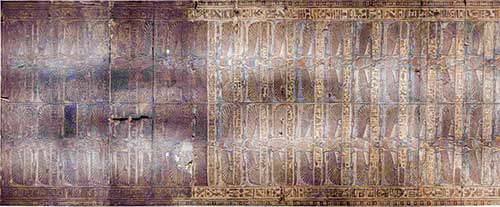
Le temple d'Esna est dédié à Khnoum, un ancien dieu bélier associé à la fertilité et à l'eau. Les inscriptions dans le temple montrent qu'il a été utilisé pendant près de 400 ans - entre le règne du pharaon Ptolémée VI (règne 180 av. J.-C. à 145 av. J.-C.) et celui de l'empereur romain Decius (règne 249 à 251 après J.-C.)
Des chercheurs allemands de l'Université de Tübingen ont découvert que, sous la crasse attachée aux plafonds, il existe une série de fresques aux couleurs chatoyantes. Au niveau de la partie centrale du plafond, 46 représentations de la déesse vautour de Haute-Égypte Nekhbet et de la déesse serpent de Basse-Égypte Ouadjet ont été trouvées. Les deux divinités sont représentées comme des vautours aux ailes déployées. Nekhbet a la tête d'un vautour coiffé de la couronne blanche de Haute-Égypte, tandis que Ouadjet est reconnaissable à sa couronne de Basse-Égypte surmontée d'un cobra. Cette observation nous rappelle une fois de plus que les temples que nous voyons aujourd'hui comme bruns ou gris étaient autrefois couverts de peintures souvent éclatantes. Les couleurs ont été recouvertes d'une couche de saleté et de suie pendant près de 2000 ans - ce qui a contribué à leur conservation. Les archéologues ont également découvert, sur le mur occidental, des inscriptions à l'encre rouge, qui étaient également recouvertes de couches de suie noire. Il s'agirait d'une date précise, qui pourrait être celle à laquelle le temple d'Esna a été achevé.Plus de la moitié des plafonds et huit des 18 colonnes ont maintenant été nettoyés, conservés et documentés par une équipe dirigée par Ahmed Emam. De plus, les deux architraves de la section centrale du plafond ont été nettoyées de la suie. Ainsi, pour la première fois depuis des siècles, on peut voir tous les éléments décoratifs en relation les uns avec les autres. La phase suivante sera une traduction de toutes les inscriptions d'Esna, ainsi qu'une étude des liens entre les différentes inscriptions et les représentations à l'intérieur du temple.
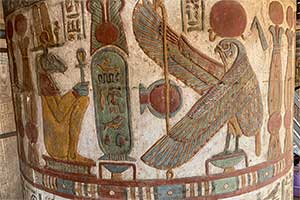

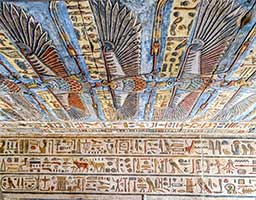
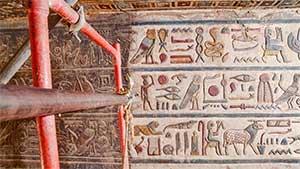
The temple of Esna is dedicated to Khnum, an ancient ram god associated with fertility and water. Inscriptions on the temple show that it was used for nearly 400 years — between the time of pharaoh Ptolemy VI (reign 180 B.C. to 145 B.C.) and the Roman emperor Decius (reign A.D. 249 to 251).
A German team from the University of Tübingen have uncovered a series of vibrantly-colored ceiling frescoes. The relief images in the central section of the ceiling make up a total of 46 depictions of the Upper-Egyptian vulture goddess Nekhbet and the Lower-Egyptian snake goddess Wadjet. Both are depicted as vultures with outspread wings. While Nekhbet bears the head of a vulture and the white crown of Upper Egypt, Wadjet can be recognized by the Lower-Egyptian crown topped with a cobra. This observation reminds us once again that the temples we see today as brown or grey were once covered with often brilliant paintings. The colors have been covered by a coating of dirt and soot for almost 2000 years, and this has helped to conserve them. Archaeologists also discovered inscriptions in red ink on the western wall, which were also covered with layers of black soot. This would indicate a specific date, which could be the date when the temple of Esna was completed.
More than half of the ceilings and eight of the 18 columns have now been cleaned, conserved and documented by a team headed by Ahmed Emam. In addition, the two architraves of the central section of the ceiling have been cleaned of soot. Thus, for the first time in centuries, we can see all the decorative elements in relation to one another. Now, there is a large project funded by the German research Foundation : a translation of all the Esna inscriptions, and also a study of the connections between the various inscriptions and the depictions in the interior of the temple.
Découverte dans le Sinaï d'un temple du dieu grec Zeus KasiosRemains of temple to the Greek god Zeus Kasios uncovered in Sinai
Photos: Ministry of Tourism and Antiquities (MoTA)

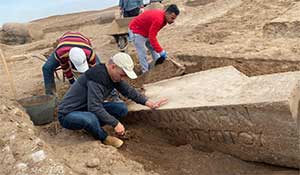
Une équipe d'archéologues égyptiens travaillant à Tel Al-Farma, la ville antique de Pelusium, dans le nord-ouest du Sinaï, a découvert les éléments d'un temple dédié au dieu grec Zeus-Kasios. Rencontre de deux identités religieuses - Zeus, le roi des Dieux grecs, qui trône dans l'Olympe et les anciennes traditions religieuses du Mont Kasios. Ce mont est situé le long de la frontière (moderne) entre la Syrie et la Turquie, actuellement une zone militaire. Fusion d'anciennes traditions religieuses, Zeus Kasios est un exemple du multiculturalisme religieux dans l'Antiquité.
Le mont Kasios était déjà un site de culte cananéen. Il était considéré comme sacré par plusieurs cultures anciennes, parfois comme la demeure de tous les dieux. C'est là que le dieu de l'orage Ba'al Zephon était adoré. Les habitants de l'ancienne ville d'Ougarit vénéraient également la place comme étant l'emplacement du palais de Ba'al et de sa sœur Anat. Le mont Kasios est mentionné dans la Bible sous le nom de mont Zaphon.
Le temple dédié à Zeus-Kasios a été construit en briques crues sur une plate-forme surélevée, et son plafond était soutenu par des colonnes de granit rose. Un escalier ascendant recouvert de marbre était probablement utilisé par les fidèles pour atteindre le toit du temple.
Les premières fouilles sur le site ont été menées en 1910 par l'archéologue français Jean Clédat, qui a découvert des inscriptions en grec tardif sur un linteau; elles indiquaient la présence d'un temple, mais Clédat ne l'a pas retrouvé. Lorsque les recherches ont repris, les restes du temple ont été trouvés près de la porte d'entrée dans la ville (détruite lors d'un tremblement de terre). Deux énormes colonnes de granit tombées étaient visibles sur le sol. Les inscriptions trouvées sur certains des blocs de granit suggèrent que l'empereur romain Hadrien (qui a régné de 117 à 138 ans) a rénové le temple.
La ville de Pelusium remonte à la fin de la période pharaonique et perdure pendant les périodes gréco-romaine et byzantine. C'était une capitale provinciale romaine, puis plus tard un centre spirituel chrétien. La ville avait aussi un rôle militaire important de forteresse frontalière qui devait protéger l'Égypte des attaques venant de la mer et des ennemis du nord, venant de Syrie.
A team of Egyptian archaeologists working at Tel Al-Farma, the ancient city of Pelusium, in northwestern Sinai, have uncovered evidence of a temple to the Greek god Zeus-Karios. Conflation of two religious identities – the Greek sky god Zeus and the ancient religious traditions of Mount Kasios. This mount is located along the modern-day border of Syria and Turkey, currently a military zone. A merger of ancient religious traditions, Zeus Kasios is an example of the legacy of religious multiculturalism in antiquity.
In Greek mythology, Mount Kasios is associated with the great cosmic battle that took place for supremacy between Zeus and his greatest enemy, the storm monster Typhon. The mount was also an ancient Canaanite cult site. It was considered sacred by several ancient cultures, sometimes as the home of all gods, and was where the storm god Ba'al Zephon was worshiped. People of the ancient port city of Ugarit also venerated the mountain as the location of the palace of Ba'al and his sister Anat. Mount Kasios is mentioned in the Bible as Mount Zaphon.
The Zeus-Kasios temple in the Sinaï was built of mud bricks on a raised platform, and its ceiling was supported by columns of pink granite. An ascending stairway covered with marble was likely used by worshipers to reach the temple platform.
First excavations at the site were carried out in 1910 by French archaeologist Jean Clédat, who discovered late Greek inscriptions on a lintel that indicated the presence of the temple, but he didn't find it. When researches were resumed, the remains of the temple were found close to the entrance gate of the town (destroyed in an earthquake). Two huge fallen granite columns were visible on the ground. Inscriptions found on some of the granite blocks suggest that Roman Emperor Hadrian (ruled A.D. 117-138) renovated the temple.
The city of Pelusium dates back to the late Pharaonic period continuing through the Greco-Roman and Byzantine periods. It was a Roman provincial capital and then later a Christian spiritual center. An important border fortress city in the eastern extremes of the Egyptian Nile Delta, any military attack from the east first needed to conquer the city. Pelusium was meant to protect Egypt from attacks coming from the sea and from northern enemies in Syria.
Saqqara : découverte de la tombe d'un fonctionnaire "dans les secrets du roi"Saqqara: discovery of a royal official's tomb
Photos: Polish Centre of Mediterranean Archaeology, University of Warsaw
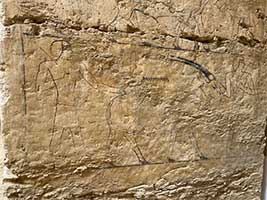
Une équipe d'archéologues polonais, dirigée par le Pr Kamil Kuraszkiewicz (Université de Varsovie), a découvert à Saqqara la tombe vieille de 4300 ans d'un homme nommé Mehtjetjou. La tombe est creusée dans la rive est de ce qu'on appelle le Dry Moat ("douves sèches"). Il s'agit d'un énorme fossé rectangulaire (environ 750 m sur 600 m) comblé de sables et de débris, entourant le complexe de la pyramide à degrés de Djoser, construite il y a environ 4700 ans. Dans le Dry Moat, les archéologues ont découvert la façade de la tombe de Mehtjetju, comprenant des inscriptions hiéroglyphiques, des peintures grossières et un relief gravé représentant le propriétaire de la tombe.
Ainsi, bien que Djoser soit mort quatre siècles avant Mehtjetjou, il garde encore un prestige important et certains fonctionnaires ont obtenu l'autorisation d'être enterrés près de la pyramide de ce grand souverain.
Mehtjetjou annonce fièrement avoir accès à des documents royaux scellés (c'est-à-dire secrets) dans la chancellerie royale pendant le règne des premiers pharaons de la sixième dynastie (vers 2300 av. J.-C.). Il est également inspecteur du domaine royal et prêtre rattaché à la pyramide du roi Teti. Cela signifie qu'il a très probablement vécu pendant les règnes des trois premiers souverains de la Sixième Dynastie : Teti, Ouserkare et Pepy I, et donc à peu près à la même époque que le vizir Merefnebef dont la tombe merveilleuse est proche de la sienne [Ne manquez pas la tombe de Merefnebef sur notre site].
La position sociale élevée de Mehtjetjou lui a permis d'engager des artisans de haut niveau pour aménager sa sépulture : les reliefs, l'élégance des lignes et la subtilité du modelé rivalisent avec les meilleurs reliefs de la tombe du vizir. Malheureusement, la roche dans laquelle la chapelle a été sculptée est très fragile et érodée, elle a donc nécessité l'intervention immédiate des conservateurs.On ne trouve aucune polychromie sur la façade.
"Il est possible qu'elle n'ait jamais été réalisée, car la décoration de la chapelle n'était pas terminée. Les murs latéraux de l'entrée n'ont pas de décoration en relief, juste des figures peintes à l'encre noire sur du plâtre à la chaux"explique Kuraszkiewicz. Les esquisses étaient destinées à servir d'ébauches pour la sculpture des reliefs. représentent la conduite d'animaux sacrificiels : vaches, oryx et bouquetins.
La décoration incomplète ne signifie pas que Mehtjetju n'a pas été déposé dans sa tombe. L'exploration de l'intérieur de la chapelle est prévue pour l'automne 2022. Je ne manquerai pas de vous informer.
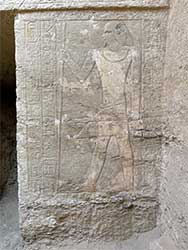
A team of Polish archaeologists, headed by Pr Kamil Kuraszkiewicz (University of Warsaw) has discovered at Saqqara the 4,300-year-old tomb of a man named Mehtjetju. The tomb is hewn in the eastern bank of the so-called Dry Moat, a huge ditch on a rectangular plan (approx. 750 by 600 m) surrounding the complex of the Step Pyramid). There, archaeologists uncovered the tomb's decorated entrance facade, including hieroglyphic inscriptions, rough paintings, and a relief depicting the tomb's owner.
The Step Pyramid was built 4,700 years ago by King Djoser, who remained, four centuries after his death, an important and revered king. So, officials sometimes wanted to be buried beside his pyramid, even centuries after Djoser died.
Mehtjetju is an official who claimed that he had access to royal sealed (ie secret) documents in the royal chancellery during the reign of the first pharaohs of the Sixth Dynasty (c. 2300 BC). Mehtjetju was also an inspector of the royal estate and a priest at the pyramid of king Teti. This means that he most likely lived during the reigns of the first three rulers of the Sixth Dynasty: Teti, Userkare and Pepy I, and thus at about the same time as Vizier Merefnebef whose wonderful tomb is close to Mehtjetju's. [Don't miss the tomb of Merefnebef on our site].
Mehtjetju's high social position allowed him to hire skilled artisans to build the tomb, as the reliefs on the façade betray an exceptionally skilled hand, and the elegance of the lines and subtlety of the modeling rival the best reliefs in the vizier's tomb. Unfortunately, the rock in which the chapel was carved is very brittle and eroded, so it required the immediate intervention of conservators.
No polychromy is found on the façade. "It is possible that it was never created because the decoration of the chapel was not completed. The side walls of the entrance have no relief decoration, just figures painted in black ink on lime plaster"
says Kuraszkiewicz. They were meant as a draft for the carving of the reliefs. The sketches depict the leading of sacrificial animals: cows, oryxes, and ibexes.
The incomplete decoration does not mean that Mehtjetju was not laid to rest in his tomb. Exploration of the interior of the chapel is planned for fall 2022. I will be sure to keep you informed.
Découverte à proximité du site de Bérénice d'une tombe de l'éliteBerenike discoveries: an elite tomb with complete set of grave goods
Photos: Polish Centre of Mediterranean Archaeology, University of Warsaw

Une autre mission polonaise, dirigée par le Dr Mariusz Gwiazda, a découvert un complexe funéraire à proximité de l'ancien port maritime de Berenike Troglodytica, sur les rives de la mer Rouge. Berenike a été construit par Ptolémée II au début du 3e siècle avant J.-C. et a été un port commercial prospère pendant toute l'Antiquité. Du 4ème au 6ème siècle de notre ère, la région était habitée par les Blemmyes, une tribu du désert oriental.
Le complexe funéraire contenait sept squelettes, datant d'environ 1500 ans, enterrés en plusieurs couches dans un "coffre" de pierre. Les corps étaient positionnées avec les membres inférieurs reposant sur la poitrine, ce qui n'est pas une position naturelle. Pour l'obtenir, le défunt devait être lié avec des cordes ou attaché avec du tissu.
Divers types d'équipements ont été trouvés dans la tombe, ce qui prouve qu'elle appartenait à des personnes de statut social élevé. Parmi les objets trouvés, il y avait notamment des perles en onyx et en cornaline, grossièrement taillées. Elles ont voyagé depuis le Pakistan, l'Inde et même l'Indonésie, ce qui montre que la cité était bien ouverte sur l'Orient. Pour leur dernier voyage, on avait passé aux défunts, des bagues et boucles d'oreilles en argent, ainsi que des bracelets en ivoire.
Les fouilles ont également retrouvé les places d'anciens rituels funéraires par la découverte d'une plate-forme et de restes d'animaux probablement utilisés pour les sacrifices. Sur la plate-forme se trouvaient des bols (utilisés pour les offrandes) et plusieurs amphores placées à l'envers qui étaient vidées lors des pratiques rituelles.
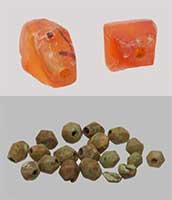
Another Polish mission, headed by Dr Mariusz Gwiazda, has announced the discovery of a tomb complex in the vicinity of the ancient seaport of Berenike Troglodytica on the banks of the Red Sea. Berenike was constructed by Ptolemy II during the early 3rd century BC and was a prosperous trading port throughout antiquity. During the 4th to 6th century AD, the region was inhabited by the Blemmyes, an Eastern Desert tribe. The tomb complex contained seven skeletons, from around 1500 years ago, buried in multiple layers. The burials were positioned with the lower limbs resting on the chest, which is not a natural position. In order to achieve it, the deceased had to be bound with ropes or tied with cloth.
Various types of equipment were found in the tomb, which proves that it belonged to high social status persons of this ancient city. Among the items found were rough-cut onyx and carnelian beads. They found their way to Berenike from Pakistan, India and even Indonesia. For the last journey of the dead, several silver rings and earrings and bracelets made of ivory were also fitted.
Excavations also revealed evidence of ancient funeral rituals by the discovery of a platform and animal remains likely used for sacrifices. On the platform were bowls used for offerings and several amphorae placed upside down that were emptied during ritual practices.
Découverte à Saqqara de la plus grande cache d'objets en bronze jamais trouvée à ce jourEgyptian archaeologists unearth largest-ever bronze statues cachette in Saqqara
Photos: Ministry of Tourism and Antiquities (MoTA)

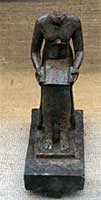
statue of engineer Imhotep
La mission archéologique égyptienne travaillant dans le cimetière de Bubasteion, dans la nécropole de Saqqara, a mis au jour une collection de 250 cercueils en bois peint et la plus grande cache d'objets votifs ou cultuels en bronze jamais trouvée en Égypte : 150 statuettes en bronze de petite ou moyenne taille de divinités traditionnelles, Anubis, Bastet, Hathor... ainsi que des instruments de culte. Tous sont de la période tardive.
Les cercueils sont peints, parfois dorés, et contiennent des momies bien conservées. Des amulettes, des boîtes en bois, des miroirs... ont été trouvés avec les cercueils.

The Egyptian archaeological mission working in the Bubastion Cemetery at the Saqqara necropolis unearthed a collection of 250 wooden painted coffins and the biggest ever bronze cachette containing a collection of 150 small or middle sized bronze statues of traditionnal deities, Anubis,Bastet, Hathor... as well as cult instruments. All are from the Late Period.
The coffins are painted, sometimes gilded, and contain well preserved mummies. Amulets, wooden boxes... were unearthed along with the coffins.
-- Sent from my Linux system.







:focal(3034x1705:3035x1706)/https://tf-cmsv2-smithsonianmag-media.s3.amazonaws.com/filer_public/ec/16/ec1671ec-f23b-434b-a486-68b4721f90f6/gettyimages-1240562858.jpg)
/https://tf-cmsv2-smithsonianmag-media.s3.amazonaws.com/filer_public/07/d2/07d271da-bf4e-40d1-9875-f85b75e00d51/download.jpg)
/https://tf-cmsv2-smithsonianmag-media.s3.amazonaws.com/accounts/headshot/41477355_2034354926624651_7778600430673592320_n.jpg)